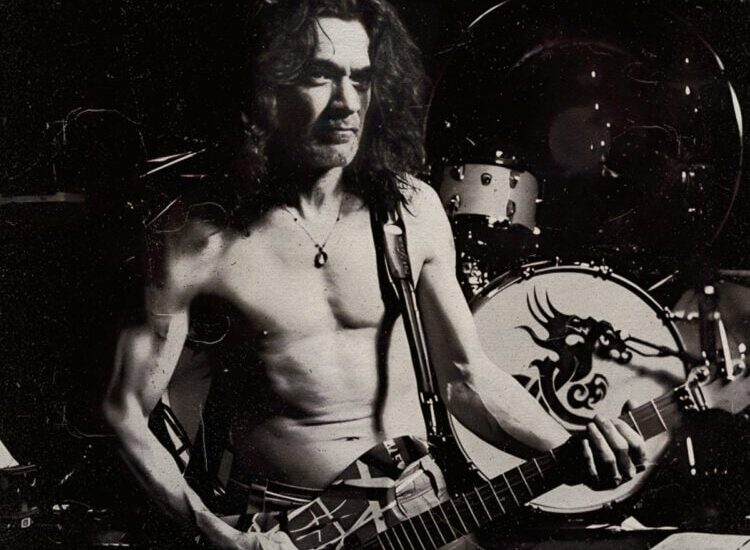
Just In:“How to make the guitar talk”: Eddie Van Halen once revealed the key to his unique sound….
Eddie Van Halen, a legendary guitarist and innovator, transformed rock guitar with his unique sound, techniques, and style. The phrase “How to make the guitar talk” refers to Eddie’s ability to create expressive, vocal-like sounds on the guitar, a feat that was unprecedented at the time and remains one of his defining contributions to rock music. Through a blend of technical mastery, inventive techniques, and unconventional thinking, Van Halen’s sound became instantly recognizable and influenced generations of guitarists. In this article, we’ll explore how Eddie Van Halen achieved his “talking” guitar sound, breaking down some of the key elements and techniques that made his playing so distinctive.
The Art of Tapping: Van Halen’s Signature Move
One of the most iconic elements of Eddie Van Halen’s style is his use of two-handed tapping. While tapping itself was not invented by Van Halen (it had been used by other guitarists before him), Eddie’s use of the technique was revolutionary and elevated it to new heights. The technique involves using the fingers of the picking hand to tap the fretboard while the fretting hand continues to play notes, allowing for rapid, fluid, and melodious runs that sound almost like vocal lines.
On tracks like “Eruption,” Eddie demonstrated his tapping technique, using it to create a sound that was both melodic and percussive. His tapping wasn’t just about speed or flash; it was about expression. In interviews, Eddie emphasized that tapping was about creating new sounds that were previously impossible with traditional guitar techniques. The result was a guitar that could “speak” with a voice-like quality—an instrument capable of delivering rapid bursts of notes that felt like a conversation rather than a series of mechanical notes.
Harmonics: Creating a Sonic Landscape
Another crucial component of Eddie’s sound was his use of harmonics—specifically artificial harmonics. While harmonics have been used in guitar playing for centuries, Eddie pushed them to new extremes. He was known for coaxing harmonics from the guitar in ways that others had never thought of, using both his thumb and fingers to pluck strings in specific ways that caused the strings to vibrate in high-pitched, bell-like overtones.
On songs like “Mean Street,” Eddie used harmonics to punctuate his riffs, giving the guitar a voice-like quality that seemed to breathe with intensity and feeling. He would often use pinch harmonics in combination with his trademark dive bombs, creating dramatic and exaggerated pitches that had a vocal-like, almost whiny character. This extended the palette of sounds available to the guitar and contributed to his signature sound.
The Whammy Bar: Expressing Emotion
Eddie Van Halen’s use of the whammy bar, or tremolo arm, was another way he made the guitar “talk.” Many guitarists use the whammy bar for subtle pitch bends or vibrato, but Eddie used it in more extreme and expressive ways. He often combined whammy bar dives with harmonics or tapped lines to create unpredictable and dramatic sounds that would shift pitch and tone almost like a human voice.
One of the most famous examples of Eddie’s whammy bar technique is the opening to “Jump,” where he uses subtle pitch bends to add expressiveness and nuance to the notes. But Eddie also took things further, using the whammy bar to create strange, wailing sounds in solos, such as in “Hot for Teacher” and “Unchained.” The technique gave his guitar playing a sense of urgency and drama, and became a hallmark of his style.
Tone: The Secrets Behind Van Halen’s Sound
No discussion of Eddie Van Halen’s sound would be complete without mentioning his tone. The unique warmth and clarity that defined his guitar sound were achieved through a combination of factors, including his choice of guitar, amplifier, and the special modifications he made to his gear.
The most famous of Eddie’s guitars is the “Frankenstrat”—a custom-built guitar that was a combination of different parts from various guitars. Eddie’s desire to break away from traditional guitar designs led him to combine a Stratocaster body with a Gibson-style humbucker pickup, among other modifications. This hybrid design allowed for the best of both worlds: the bright, cutting tone of a Stratocaster with the fat, powerful sound of a humbucker.
The Frankenstrat was fitted with a single humbucking pickup in the bridge position, which was crucial to Eddie’s powerful distortion sound. The pickup was connected to a custom-wound set of electronics, and Eddie famously used Marshall amplifiers with high gain settings to achieve his crunchy, saturated tone. But Eddie’s tone wasn’t just about cranking the gain; he paid careful attention to his EQ settings, particularly in the midrange, to create a sound that was both cutting and rich with sustain.
You may also like
Archives
Categories
- ABA
- Actor
- Actress
- Actress and singer
- Band
- Baseball
- Basketball
- Boxer
- Broadcasting corporation
- CCR
- cricketer
- Cyclists
- Dart
- Drummer
- Fictional character
- Football game
- Formula 1
- Golf
- Guitarist and songwriter
- Guitarists
- Gymnastics
- Hockey
- Ice hockey
- Marathon
- MLB
- Motocross
- MotoGP
- Motorcross
- Musician
- Musician and drummer
- NFL
- NHL
- NRL
- Racer
- Red bull Racing
- Rider
- Rock band
- Rugby league
- Simone Biles
- Singer and songwriter
- Songwriter and musician
- Sport commentator
- Tennis
- Texas longhorns
- Track and field athlete
- Uncategorized
Leave a Reply